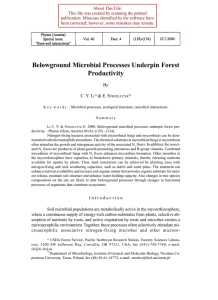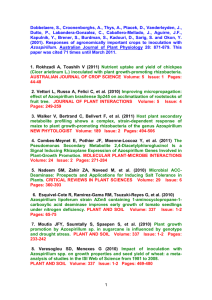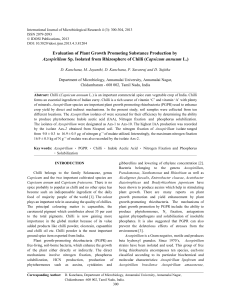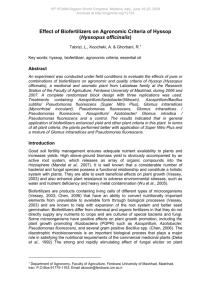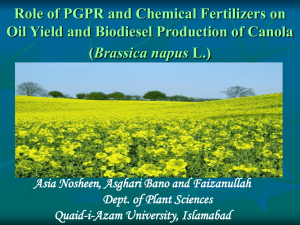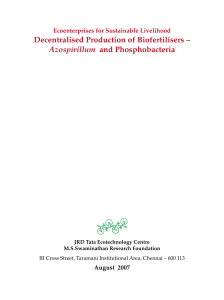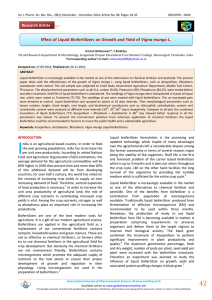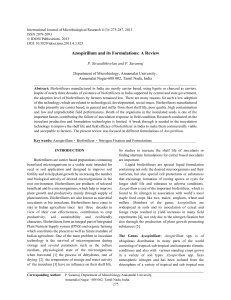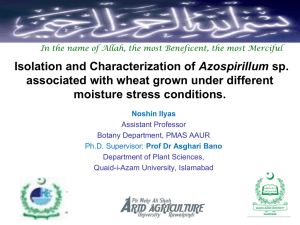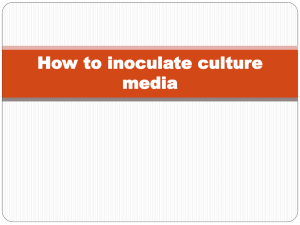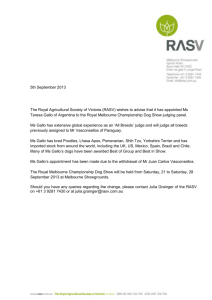Bio-Fertilizer 25 KB - Continually improving your experience
advertisement
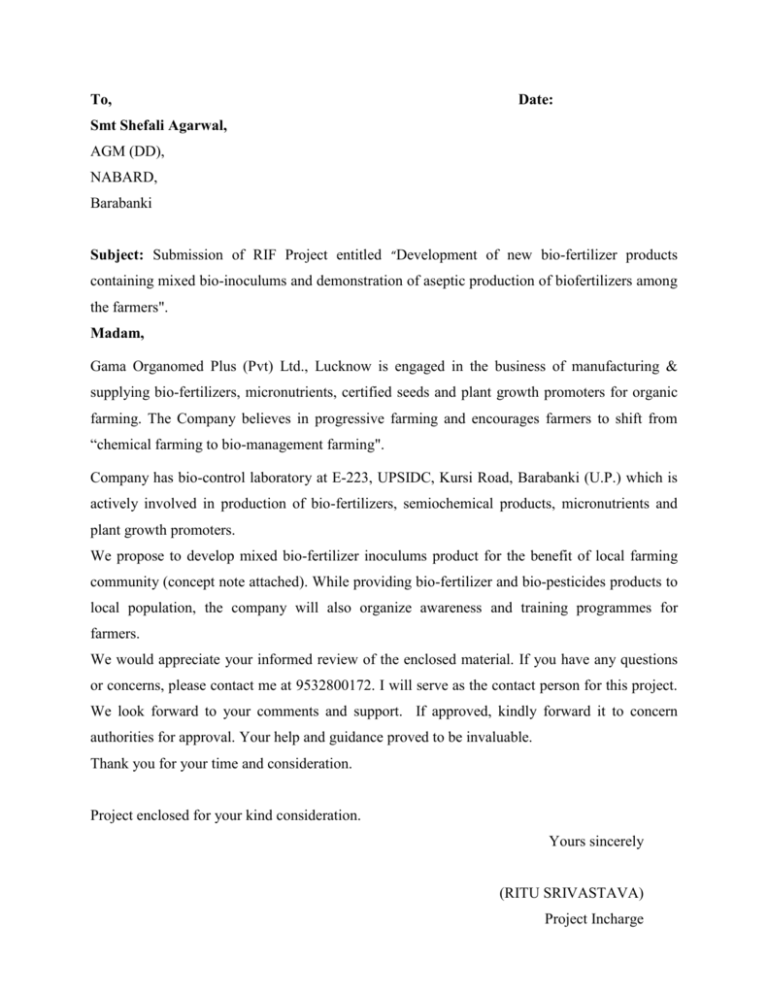
To, Date: Smt Shefali Agarwal, AGM (DD), NABARD, Barabanki Subject: Submission of RIF Project entitled “Development of new bio-fertilizer products containing mixed bio-inoculums and demonstration of aseptic production of biofertilizers among the farmers". Madam, Gama Organomed Plus (Pvt) Ltd., Lucknow is engaged in the business of manufacturing & supplying bio-fertilizers, micronutrients, certified seeds and plant growth promoters for organic farming. The Company believes in progressive farming and encourages farmers to shift from “chemical farming to bio-management farming". Company has bio-control laboratory at E-223, UPSIDC, Kursi Road, Barabanki (U.P.) which is actively involved in production of bio-fertilizers, semiochemical products, micronutrients and plant growth promoters. We propose to develop mixed bio-fertilizer inoculums product for the benefit of local farming community (concept note attached). While providing bio-fertilizer and bio-pesticides products to local population, the company will also organize awareness and training programmes for farmers. We would appreciate your informed review of the enclosed material. If you have any questions or concerns, please contact me at 9532800172. I will serve as the contact person for this project. We look forward to your comments and support. If approved, kindly forward it to concern authorities for approval. Your help and guidance proved to be invaluable. Thank you for your time and consideration. Project enclosed for your kind consideration. Yours sincerely (RITU SRIVASTAVA) Project Incharge "NEED TO DEVELOP NEW BIO-FERTILIZER PRODUCTS CONTAINING MIXED BIO-INOCULUMS " Among the major concerns in today's world are the pollution and contamination of soil by excessive and injudicious use of agrochemicals, along with insect pests, diseases and weeds which inflict enormous losses to the potential agricultural production. There is a rising public concern about the potential adverse effects of chemical pesticides on the human health, environment and biodiversity. These negative externalities, though, cannot be eliminated altogether; their intensity can be minimized through development, dissemination and promotion of alternative technologies such as bio-pesticides, bio-fertilizers and bio-agents as well as good agronomic practices rather relying solely on chemical pesticides. The declining trend in pesticide use in agriculture during the 1990s can be attributed to Government of India fiscal policy and technological developments in pest management. Programmes on training of both the extension workers and farmers in the Integrated Pest Management (IPM) were started throughout the country. India continues to be one of the largest consumers of fertilizers with the total consumption in 2009-10 estimated at 53.3 million tons in terms of various products as against 50.7 million tons in the previous year. Region wise production trend analysis in India shows wide variations across the country (Thirty-seventh report standing committee on petroleum & chemicals, 2002). Western India has the highest bio-fertilizer production capacity as it can be seen that for the 1999-2000 the estimated production in this region was 5098.2 tons and it was expected grow upto 6429.9 tons by 2000-01 (FAI, 1999-2000). Southern India has the second largest biofertilizer producing region with 4491.6 tons for 1999-2000 and 6117.5 tons for 2000-01. Inspite of the huge agricultural production base in Northern India, the production of bio-fertilizer stood at 207.2 tons for 1999-2000. From 1998 to 2002, value of bio-fertilizer distributed in Uttar Pradesh has increased from around Rs 2 Lakh in 1997-98 to Rs. 7 Lakh in 2001-02. MIXED BACTERIAL INOCULANTS: CONCEPT Numerous recent studies show a promising trend in the field of inoculation technology. Microbial studies performed without plants indicate that some mixtures allow the bacteria to interact with each other synergistically, providing nutrients, removing inhibitory products, and stimulating each other through physical or biochemical activities that may enhance some beneficial aspects of their physiology, like nitrogen fixation. It still has to be demonstrated that these bacterial synergistic effects also benefit plant growth. An example of this is Azospirillum, one of the most studied bacteria that associate with plants. It may associate with sugar- or polysaccharide-degrading bacteria (Bacillus, Pseudomonas, etc), establishing a metabolic association where the sugar-degrading bacteria produce degradation and fermentation products used by Azospirillum as a carbon source, which in turn provides PDB with nitrogen. Other examples are the association between Azospirillum and Bacillus that degrades pectin, Azospirillum and Cellulomonas that degrades cellulose, and Azospirillum and Emerobacter cloacae that ferments glucose (Kaiser, 1995; Khammas and Kaiser, 1992; Halsall, 1993). Plant studies have shown that the beneficial effects of Azospirillum on plants can be enhanced by coinoculation with other microorganisms. Co -inoculation, frequently, increased growth and yield, compared to single inoculation, provided the plants with more balanced nutrition, and improved absorption of nitrogen, phosphorus, and mineral nutrients. Thus, plant growth can be increased by dual inoculation with Azospirillum and phosphate-solubilizing bacteria (Alagawadi and Gaur, 1992). Azospirillum is also considered to be a Rhizobium-"helper" stimulating nodulation, nodule activity, and plant metabolism, all of which stimulate many plant growth variables and plant resistance to unfavorable conditions (Andreeva et al., 1993; Fabbri and Del Gallo, 1995). Other successful combinations include Azospirillum or Azotobacter mixed with Streplomyces (Elshanshoury, 1995). In vitro studies of the effect of P. fluorescens on Rhizobium growth showed the existence of a positive interaction between them, with no significant reduction in growth of either bacterial inoculant. Combined inoculation was found superior than individual inoculation. These studies point out further advantages of mixed cultures over single strains: i) In vitro studies have shown that Azospirillum can produce more phytohormones when grown in mixed culture (Janzen et al., 1992), ii) Mixed cultures provide conditions more suitable for nitrogen fixation than pure cultures (Drozdowicz and Ferreira-Santos, 1987; Holguin and Bashan, 1996) iii) Mixed inoculation of biocontrol microorganisms is more efficient in controlling pathogens than the use of single -strain inoculants, e.g., combinations of Pseudomonas with Serratia (Frommel et al., 1991) and Pseudomonas with a nonpathogenic Fusarium (Lemanceau and Alabouvette, 1991). Despite progress in research on mixed inoculants, they are not yet produced commercially. REFERENCES Alagawadi, A.R. and Gaur, A.C. (1992). Inoculation of Azospirillum brasilense and phosphatesolubilizing bacteria on yield of sorghum [Sorghum bicolor (L.) Moench] in dry land. Trop. Agric. 69: 347-350. Elshanshoury, A.R. (1995). Interactions of Azotobacter chroococcum, Azospirillum brasilense and Streptomyces mutabilis, in relation to their effect on wheat development. J. Agron. Crop Sci.175: 119-127. Fabbri, P. and Del Gallo, M. 1995. Specific interaction between chickpea (Cicer arietinum) and three chickpea-Rhizobium strains inoculated singularly and in combination with Azospirillumbrasilense Cd. In Azospirillum VI and related microorganisms, genetics - physiology -ecology, I. Fendrik, M. Del Gallo, J. Vanderleyden and M. de Zamaroczy (eds.), Vol. G37: 257-267, NATO ASI Series, Series G: Ecological Sciences, Springer Verlag, Berlin, Heidelberg, Germany. Halsall, D.M. (1993). Inoculation of wheat straw to enhance lignocellulose breakdown and associated nitrogenase activity. Soil Biol. Biochem. 25: 419-429. Kaiser, P. (1995). Diazotrophic mixed cultures of Azospirillum brasilense and Entrobacter cloacae. In Azospirillum VI and related microorganisms, genetics physiology-ecology, I. Fendrik , M. Del Gallo, J. Vanderleyden and M. de Zamaroczy (eds.), Vol. G37: 207-212, NATO ASI Series, Series G: Ecological Sciences, Springer Verlag, Berlin, Heidelberg, Germany. Khammas, K.M. and Kaiser, P. (1992). Pectin decomposition and associated nitrogen fixation by mixes cultures of Azospirillum and Bacillus species. Can. J. Microbiol. 38: 794-797.
